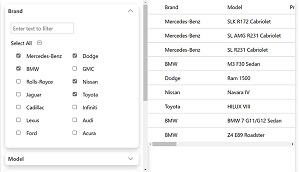News
GrapeCity ComponentOne 2021 v3 Supports .NET 6, VS 2022 and WinUI
Development toolmaker GrapeCity issued the year's final update to its ComponentOne toolkit of UI controls, adding new features for Microsoft's new .NET 6 and Visual Studio 2022 milestone releases.
The new release, called ComponentOne 2021 v3, also graduated from beta its WinUI edition, supporting Microsoft's now-decoupled native UI platform component-- serving as the company's next-gen UI library for creating Windows apps -- that ships with the Windows App SDK (formerly called "Project Reunion").
But it's the support for VS 2022 -- the first 64-bit edition of the IDE -- and the unifying .NET 6 framework that leads the update.
"Microsoft has given .NET developers a true gift with the new, optimized development platform that bridges the gap between old and new—unifying the once complicated and uneven .NET family of frameworks," said the company in a Dec. 8 blog post.
"We have migrated all .NET 5 controls to .NET 6 and released .NET 6 versions of TrueDbGrid, GanttView, FontPicker, and Scheduler. The Print Preview family of controls (C1PrintDocument and C1PrintPreviewControl) are now out of beta. .NET 6 is the first LTS (long-term support) platform in Microsoft's larger plan. With that comes at least three years of support. Visual Studio 2022 support includes toolbox, Tools add-on, and limited design-time support. The controls have been tested to work on the design surface, but not all designers from .NET Framework are supported in .NET 6."
The update also enhances Blazor functionality, notable because Microsoft actually mentions GrapeCity and other third-party tooling vendors as being "top component vendors" in its Blazor documentation.
 [Click on image for larger view.] New DataFilter Component for Blazor (source: GrapeCity).
[Click on image for larger view.] New DataFilter Component for Blazor (source: GrapeCity).
"For Blazor 2021 v3, we are shipping two versions: .NET Core 3.1 and .NET 6. The benefit of switching to .NET 6 is that you will no longer need to manually add the references to scripts and JavaScript files for each control library. Enjoy the intrinsic benefits that .NET 6 brings to Blazor, such as faster loading of WebAssembly applications," GrapeCity said.
"In this release, we focused on adding drag-and-drop functionality across the Blazor suite of controls -- ensuring the client-side behavior works well in both server and WebAssembly applications. We incorporated cross-platform DataFilter UI in Blazor for advanced Blazor datagrid and list view filtering."
Other improvements, updates and enhancements were listed for WinForms, WPF, ASP.NET MVC and other components.
More about the update is available at the ComponentOne web site.
About the Author
David Ramel is an editor and writer at Converge 360.